Top 12 HockeyStack Alternatives & Competitors on the Market Right Now

Top 12 HockeyStack Alternatives & Competitors on the Market Right Now

Your go-to-market stack shows you everything that happened and nothing about what to do next. Attribution explains which touchpoints contributed to closed deals, analytics show funnel conversion rates, and enrichment tools bring context about accounts.
But these point solutions don't trigger the next best action. They just report on the last one. The problem is that the market moved past attribution-only platforms.
The old question was "what drove this deal?" and the new one is "what should we do about this account right now?" Modern GTM AI scores accounts based on intent signals, researches target companies automatically, outlines key stakeholders, and executes the right workflow at the right time.
HockeyStack approaches this as an integrated platform — Atlas as the data layer, Odin as your AI analyst, Nova as your sales assistant, and workflows that connect actions across your stack.
But depending on your tech stack maturity, integration needs, or preference for specialized tools over an all-in-one platform, you might be evaluating alternatives that specialize in specific areas of the GTM motion.
While HockeyStack offers an end-to-end GTM AI platform, your specific situation might call for a different approach. Let's check out the top alternatives and where each one performs best.
Why HockeyStack May Not Be Right for Your GTM Org
No platform fits every team perfectly. HockeyStack leads the GTM AI category for B2B companies, but it might not be the right choice if you fall into one of these categories.
- You're an early-stage startup with one channel: HockeyStack makes sense when you're ready to scale your GTM motion intelligently. If you just launched, run one marketing channel, and have minimal data to analyze, simpler tools or free ones might serve you better until you add complexity.
- You run a B2C or e-commerce business: HockeyStack was built for complex, account-based B2B sales. The platform optimizes for long sales cycles, multiple stakeholders, and account-level intelligence, not high-volume transactional sales or individual consumer behavior.
- You need enterprise-wide business intelligence: HockeyStack focuses on your revenue engine (marketing, sales, RevOps, and customer success). If you want one platform to analyze finance, HR, operations, and revenue in the same place, you need a general BI tool instead (or in addition).
- You need deep expertise in one specific channel: HockeyStack connects all your channels and shows how they drive pipeline and revenue together. If you only care about hyper-detailed SEO analysis or advanced social listening and don't need to connect that to revenue, a specialized point solution goes deeper in that one area.
- You just want basic reporting without AI: HockeyStack offers more than just dashboards with AI-powered intelligence through Odin and Nova, plus workflow automation across your stack. If you just need simple metric visualization without strategic analysis or automation, a basic reporting tool costs less and probably gets the job done.
Top HockeyStack Competitors on the Market
The right alternative depends on what you need most from a GTM platform. Below, we’ll go over the top competitors and break down their strengths, limitations, and ideal fit. This should help you narrow down which ones deserve a closer look.
1. Dreamdata
Best for: B2B marketers who need attribution insights plus unrestricted access to export and query their unified data in their own warehouse.
Dreamdata is a B2B activation and attribution platform that unifies data from your entire GTM stack into one complete customer journey map.
The platform covers both analytics (revenue attribution, ROI measurement, journey analysis) and activation (audience building, conversion syncs, intent signals), so it functions as operational infrastructure for B2B marketers.
Key features
- Complete journey mapping: The platform stitches together website visits, ad interactions, email engagement, and CRM activity into one timeline per account.
- Audience hub: Build precise audience segments using your full GTM data, then sync them directly to major ad platforms. One-click conversion syncs feed accurate pipeline data back to platforms for better optimization.
- AI-driven attribution and activation: It uses AI to measure which channels and campaigns drive pipeline, then automatically syncs high-intent audiences to ad platforms like Google and Meta.
Limitations
Dreamdata packs in sophisticated attribution models and analytics, but that power comes with complexity. New users often need time to understand how the models work and where to find specific insights in the dashboards. Here's what this G2 user says about it:
"It can be hard to understand how the attribution models work, and the dashboards can be difficult to navigate. For example, sometimes you need to export the data in order to see the full report."
The product team moves fast and releases new features constantly. While that shows strong development momentum, some customers would prefer to see core features polished before new ones get added. Another G2 reviewer shares:
"There are new features all the time with Dreamdata, which is great, but I think there are some core elements that could be improved. I'd love to be able to build custom views within the reports, and potentially see the types of exciting integrations that they have with LinkedIn across all adtech platforms."
How Is It Different From HockeyStack?
The main difference is architectural philosophy. Dreamdata gives you attribution insights and then opens the doors for you to get full access to your cleaned data in your own warehouse and build whatever you need.
HockeyStack brings a complete GTM AI system where Atlas unifies data, Odin analyzes it, Nova executes on it, and workflows automate across your stack.
If you want an attribution tool with maximum data portability, Dreamdata fits. If you want unified GTM intelligence with built-in AI and automation, HockeyStack provides that.
Pricing
There's a free version available that handles basic B2B analytics for up to 5 team members. The entry-level paid plan (Activation) runs $750 monthly and includes 25 seats plus 10,000 monthly tracked users.
More sophisticated packages with AI attribution features and larger data allowances use custom pricing models. Trial periods of up to 30 days are offered across plans.
2. Adobe Marketo Measure (Bizible)
Best for: Enterprise B2B companies already using Salesforce or Microsoft Dynamics that need sophisticated multi-touch attribution across complex sales cycles.
Adobe Marketo Measure (formerly Bizible) is an enterprise-grade B2B marketing attribution platform that tracks every touchpoint from anonymous first visit to closed-won revenue.
The platform specializes in every-touch attribution with AI-powered models and deep CRM integration, so it’s a popular choice for organizations with long, complex buyer journeys that span multiple channels and stakeholders.
Key features
- Native Salesforce and Microsoft Dynamics integration: Built specifically for deep CRM integration with pre-built reports, custom objects, templates, and customizable dashboards that can be found directly in your CRM.
- Custom stage and GTM motion tracking: Configure buyer progression stages based on your specific funnel, track non-linear stage transitions (like when contacts return to earlier stages), and measure performance across different business units or order types.
- Offline and sales channel tracking: Also tracks physical events, direct mail, content syndication, and BDR/sales activities like calls, emails, and meetings.
Limitations
While the platform integrates directly with a few major ad platforms, you'll need to manually input spend data for others, which creates extra overhead. Here's what this G2 user says:
"Incorporating cost has to be piped in from ad platforms (Bizible does have a couple of direct integrations to pull cost, but not all), but the rest has to be input manually.
For that reason, we have been unable to get true ROI reporting in the platform and run that analysis separately."
The implementation process is another consideration. This is enterprise software built for complex B2B scenarios, which means setup takes serious time and technical expertise. This G2 user explains it:
"I can confidently say it took me and my Digital Manager upwards of 40 hours to implement across about 3 months.
The team is WONDERFUL at guiding you and letting you digest it step by step - don't get me wrong - but be prepared to break some things and potentially rebuild parts of your marketing automation solution or processes to get things in line."
Learn more → Bizible vs Dreamdata (vs HockeyStack): 2025 Comparison Guide for B2B Marketers
How Is It Different From HockeyStack?
The key difference is the ecosystem and scope. Marketo Measure operates within the Adobe marketing suite and focuses exclusively on attribution for enterprise CRM users.
The platform makes sense if you're already in the Adobe world, while HockeyStack is a more complete platform that goes live (much) faster.
Pricing
Adobe Marketo Measure is sold as an add-on to Marketo Engage (available on Prime and Ultimate plans). Pricing is not publicly disclosed, and you’ll have to get a custom quote from Adobe.
3. Google Analytics 4
Best for: Small to mid-sized B2B companies that need free website analytics and basic conversion tracking without specialized GTM attribution needs.
Google Analytics 4 is Google's free web analytics platform that tracks website traffic, user behavior, and basic conversion metrics and KPIs.
While not built specifically for B2B attribution like specialized GTM platforms, GA4 brings key analytics tools and integrates seamlessly with Google Ads and other Google products at no cost.
Key features
- Event-based tracking model: Tracks every user interaction as an event (page views, form submissions, file downloads, video plays), so you have the flexibility to analyze specific behaviors that matter for B2B journeys.
- Cross-device and cross-platform tracking: Follows users across multiple devices and platforms (website, mobile app) to understand how B2B buyers research and engage with your content throughout longer sales cycles.
- Free multi-touch attribution models: You can run multiple attribution models simultaneously (data-driven, first click, last click, linear) to see how different touchpoints contribute to conversions.
Limitations
Google Analytics 4 is powerful for what it is, but it was built as a general web analytics tool, not a B2B attribution platform.
The interface can feel counterintuitive when you try to answer complex attribution questions, and the data model doesn't align naturally with how B2B buyers move through long sales cycles. This G2 user puts it in perspective:
"It feels like it wants to fight you every step of the way once you try to dig deeper. No one has a perfect solution to properly track page views and interactions.
I find myself second-guessing the data a lot, and there never seems to be a straightforward answer for how Google keeps and discards information."
The platform also overwhelms users with features that many B2B teams never use. GA4 was designed to serve everyone from e-commerce sites to mobile apps, which means the interface is cluttered with capabilities that don't apply to B2B marketing scenarios.
"Could be a difficult-to-use interface. The overwhelming flow of information, some of which isn't looked at, never ends up being utilized by my organization. Adjunct programming ends up taking space, which negatively impacts campaign performance. Uses lots of settings that are often difficult to understand."
How Is It Different From HockeyStack?
Google Analytics 4 is a general web analytics tool that tracks website traffic and conversions across all business types, while HockeyStack is purpose-built for B2B GTM intelligence with unified attribution, AI agents, and sales execution capabilities.
GA4 mainly works for companies that need basic website analytics on a budget.
Pricing
Google Analytics 4 is completely free for standard use.
Google Analytics 360 (the enterprise version) starts at $50,000 per year and includes higher data processing limits, faster data freshness, and dedicated support, but most B2B companies will find the free version sufficient.
4. InfiniGrow
Best for: B2B marketers who prioritize budget forecasting and scenario planning over AI-powered sales execution and workflow automation.
InfiniGrow is an AI-driven revenue marketing platform built specifically for B2B SaaS marketers who need to explore data freely and make fast budget decisions.
The platform positions itself as "exploration-first" and lets marketers drill into their data instantly without waiting on technical teams or pre-built reports.
Key features
- AI-powered budget forecasting and what-if scenarios: Uses AI to forecast results based on different budget allocation scenarios before you commit spend.
- Ad hoc analytics with no-code exploration: Breaks away from rigid, pre-built dashboards by letting marketers ask questions and explore data in real time without any SQL or data team support.
- SecondBrain AI agent for autonomous insights: An AI agent that learns your business context, remembers past insights, tracks live sessions, and autonomously identifies GTM risks and opportunities.
Limitations
G2 users mentioned that they encounter bugs frequently enough that they sometimes can't access parts of the platform when they need them most, even though support responds quickly to fix issues.
"While there's great innovation, the platform is pretty buggy. They hop on and fix it every time we point it out; however, there's still a delay where we can't use the platform or part of it in times of need.
The product can also be difficult to use at times, and we often need to ask for help when creating reports to make sure we're getting the right answers and making informed decisions."
The platform's flexibility also comes with complexity. Learning how to use all the exploration features and interpret customer journey data correctly takes time and practice. Another G2 reviewer notes:
"It can be a bit challenging to grasp the full scope of the product, particularly the customer journey mapping aspect. It takes some education and regular usage to get comfortable with the product and make sure you can read the detailed insights correctly."
How Is It Different From HockeyStack?
InfiniGrow gives marketers a blank canvas to explore any question they want without pre-configured dashboards, while HockeyStack brings structured intelligence with AI agents that proactively surface insights and execute actions.
Pricing
InfiniGrow offers tiered pricing based on integration and reporting needs:
- Startup Plan: $1,500/month - Up to 7 integrations, 5 custom reports
- Growth Plan: $4,500/month - Unlimited integrations, 15 custom reports
- Enterprise Plan: Custom pricing includes a dedicated customer success manager, data warehouse access, and extra perks
Annual plans include a 30-day refund policy.
5. Caliber Mind
Best for: Large B2B organizations with complex data environments that need deep customization and strategic guidance from attribution experts, not just software.
CaliberMind operates as a "Marketing-Analytics-as-a-Service" platform where you get both software and strategic support.
The platform solves the data trust problem through a centralized model that keeps your numbers consistent across every report, plus you work directly with data scientists who understand B2B attribution problems.
Key features
- Centralized data model with guaranteed consistency: Uses a BigQuery foundation with clearly defined relationships and ACID-compliant data integrity to make sure that every report pulls from the same logic.
- Ask Cal AI assistant for instant insights: An AI agent that analyzes your marketing data and answers questions in plain language (like "where should I allocate budget to hit this target?").
- Strategic support from attribution experts: Comes with hands-on guidance from data scientists and analysts who understand B2B marketing strategies.
Limitations
Getting everything configured correctly takes time, and report performance can lag when pulling large data sets. For example, here's what this G2 user shares:
"The setup seemed complex at first, and it took time to get everything running smoothly. Some reports were slower than I expected, and I wish the interface were a bit easier to use. It is a powerful tool, but it might not be the easiest for beginners or smaller teams."
The service model also means less self-serve flexibility for technical users. Teams that want to customize API parameters or adjust configurations quickly often need to route requests through customer support instead of making changes themselves.
"Lack of customizability in what we consume from the API. Would love to be able to set our own constraints rather than have to work through customer support to set them."
How Is It Different From HockeyStack?
CaliberMind is a service-first platform where data scientists and analysts guide your attribution strategy and handle customizations.
It suits enterprises that want expert human support, while HockeyStack suits teams that want intelligent software they can operate independently.
Pricing
CaliberMind works on an enterprise pricing model that's customized based on your data requirements and go-to-market setup.
Some third-party sources claim that annual costs generally fall between $20,000 and $57,000, with the final price depending on your feature set and data volume.
6. UserGems
Best for: Revenue teams focused on signal-based prospecting (tracking job changes, new hires, promotions) with AI agents that write personalized outreach automatically.
UserGems is an AI signal platform that spots high-potential buyers through buying signals like job changes, new hires, and promotions, then automates outbound campaigns with AI-generated messaging.
The platform monitors when past customers switch companies, spots new decision-makers joining target accounts, finds lookalike prospects that match your ICP, and deploys its Gem-E AI agent to write personalized email sequences.
Key features
- Gem-E AI agent for automated outreach: AI agent analyzes signals and first-party data to automatically write personalized email sequences and cold call talk tracks for each prospect.
- Job change tracking for warm pipeline: Monitors contacts in your CRM (customers, closed-lost deals, product users) and automatically creates them as new leads when they switch companies, complete with updated contact information and previous relationship context.
- Pre-built playbooks and workflow automation: Offers ready-to-activate plays for different signals that trigger actions across your stack (creating leads in Salesforce, sending Slack alerts, adding to sequences, enriching records).
Limitations
The filtering options don't provide enough granularity to slice through large volumes of signals effectively. One G2 user talked about this in more detail:
"While UserGems is fantastic overall, I do wish the platform had a slightly better way to filter leads based on specific criteria. Sometimes it can be a bit overwhelming with the amount of data, and it would be great to have more granular control over the search function."
The platform also lacks self-service controls for how and when leads flow into your CRM. Users can't trigger batch sends manually or set up automated schedules themselves, which creates friction when you want more control over timing. Here's what another G2 reviewer experienced:
"I do wish I could self-serve and trigger the send of the UserGems batches into our system either in an automated way or by me clicking a button within the platform."
How Is It Different From HockeyStack?
UserGems specializes in sales prospecting through signals and automated outreach generation, while HockeyStack solves the GTM intelligence problem with attribution, AI analysis, and workflow automation across your revenue operations.
Pricing
UserGems has three main packages:
- Core: $2,500/month for up to 3 admins, 20 end users, 25k records (1x ROI guarantee, $3k implementation)
- Advanced: $4,250/month for up to 5 admins, 40 end users, 60k records (2x ROI guarantee, $5k implementation)
- Elite: $6,000/month for up to 10 admins, 70 end users, 100k records (3x ROI guarantee, $10k implementation)
All plans include AI agents for list building, account prioritization, and automated campaigns. Startups under 80 employees should contact them for Starter pricing.
7. Ruler Analytics
Best for: SMBs and mid-market companies that need to track offline conversions (phone calls, forms, live chat) and connect them to marketing sources.
Ruler Analytics handles closed-loop marketing attribution with a focus on tracking conversions that happen outside typical web forms (e.g., phone calls, live chat conversations, and in-person interactions).
It maps anonymous visitor journeys across multiple sessions back to their eventual conversions, then feeds that attribution intelligence into your CRM and analytics stack.
Key features
- First-party visitor-level tracking: Follows anonymous visitors across multiple sessions and touchpoints while collecting UTMs, click IDs, page views, and referrer information.
- CRM and analytics enrichment: Fires attribution data directly into your CRM (Salesforce, HubSpot, Pipedrive) and lead generation analytics tools (Google Analytics, Google Ads).
- Revenue scraping and closed-loop reporting: When leads convert into customers, Ruler scrapes the revenue data from your CRM and sends it back to your marketing analytics tools for easier decision-making.
Limitations
Ruler Analytics handles many attribution scenarios well, but the platform stops short of showing the complete picture between first and last touch.
If you need to see every single interaction in a customer's journey, you'll hit the platform's boundaries. One G2 user explains the constraint:
"The only downside is total end-to-end attribution, which isn't readily available as you can only see the first and last click of the user journey."
How Is It Different From HockeyStack?
Ruler Analytics specializes in tracking offline conversions like phone calls and live chat back to their marketing sources, while HockeyStack provides a complete GTM AI platform with unified intelligence and automated workflows.
If you need call tracking with basic attribution, Ruler fits. If you want end-to-end GTM intelligence with AI agents and execution tools, HockeyStack brings that to the table.
Pricing
Ruler Analytics works on 12-month agreements with monthly or annual payment options. Pricing is based on monthly visitor volume:
- Small Business: From £179/month ($249/month) - For lower traffic volumes
- Medium Business: £499/month ($690/month) - For growing companies with moderate traffic
- Large Business: £999/month ($1,380/month) - Based on 100,000 monthly visits
- Enterprise: Custom pricing - For high-volume sites or specialized needs
Final pricing depends on your specific monthly traffic, integration needs, and required features. Call tracking may include extra per-minute charges.
8. Demandbase One
Best for: Enterprise teams running multi-channel ABM campaigns who need account-level insights combined with programmatic advertising capabilities.
Demandbase One is an account-based GTM platform that brings together your internal data and external signals to help you find accounts ready to buy, coordinate your outreach across channels, and track what drives revenue.
It combines account intelligence, advertising, sales insights, and automation so your entire revenue team works from the same playbook.
Key features
- B2B advertising platform (DSP): The only demand-side platform built specifically for B2B that optimizes for reaching entire buying committees. You can run targeted ad campaigns across display, video, and social channels.
- Account intelligence and sales insights: Centralizes firmographic data, technographic information, contact details, engagement history, and intent signals into one account view.
- Website personalization: Dynamically customizes website content based on which account is visiting. It sets up relevant case studies and CTAs matched to their industry, company size, or stage in the buying journey.
Limitations
The platform's comprehensive feature set creates a trade-off – you get sophisticated ABM tools, but you also face complexity that takes time to master. New users struggle to understand which features apply to their specific use cases. One G2 user puts it this way:
"While Demandbase One is a powerful platform, there is a learning curve, especially for new users. Some parts of the interface can feel a bit complex at first, and it takes time to fully unlock the value of all the features."
The platform's account data also creates friction for some teams. Firmographic information can be unreliable, which becomes a problem when you're building target account lists or setting qualification criteria. Here's what another G2 reviewer experienced:
"I find the criteria to enter the account-based marketing program in Demandbase One problematic. The data regarding company revenue is often incorrect, and the employee count can be very inconsistent."
How Is It Different From HockeyStack?
The main difference is advertising infrastructure. Demandbase One includes built-in tools to buy and serve ads across display, video, and social channels.
On the other hand, HockeyStack operates as an intelligence layer that analyzes your marketing performance without executing ad campaigns directly.
Pricing
Demandbase One pricing is customized for each enterprise based on your organization's size, number of users, and which features you need. The cost structure includes a platform fee plus per-user charges.
According to third-party sources, small businesses generally see annual costs between $18,000-$32,000, mid-market firms pay around $43,000-$61,000, and larger enterprises typically invest $100,000 or more.
9. 6sense Revenue Marketing
Best for: B2B organizations that want to capture buying signals from prospects researching anonymously across the web and predict which accounts will convert before they reach out to sales.
6sense Revenue AI tracks anonymous buyer behavior across the web to see which accounts are researching your category and how close they are to making a purchase.
The platform analyzes billions of behavioral signals through its "Signalverse" data network, and then uses AI agents to automatically launch targeted campaigns and sales outreach when it detects buying intent.
Key features
- AI agents for automated engagement: AI agents analyze buyer signals and automatically execute personalized email sequences, trigger multi-channel campaigns, and recommend next-best actions to sales reps.
- Intelligent Workflows for omnichannel orchestration: Build sophisticated campaign workflows from a single drag-and-drop canvas that adapts to each buyer's journey.
- Comprehensive buying team intelligence: Maps the complete buying committee within target accounts using firmographic data, technographic insights, and contact enrichment.
Limitations
The platform's complexity slows down teams during onboarding. Even with help from the 6sense support team, users face a difficult setup process and need substantial time to learn how everything works. One G2 user shares:
"I find that using 6sense Revenue Marketing requires a significant amount of learning beforehand, which can be quite daunting.
Although the 6sense team offers assistance with setup, the initial process was still difficult and not as straightforward as I would have liked."
Contact data accuracy also creates friction in the sales process. The actual contact information often needs verification through other tools. Here's what another G2 reviewer experienced:
"Sometimes the contact information provided is outdated. The tool might identify a promising account, but the contact's name is incorrect, or the person has already left the company.
As a result, I still need to use LinkedIn Sales Navigator to track down the correct individual. I wish it could give me the exact right person to call, but it doesn't handle everything for me."
Learn more → 6sense vs. Demandbase: Head-to-Head Comparison (+ Better Options)
How Is It Different From HockeyStack?
6sense built its platform around capturing early intent signals from prospects researching anonymously on external sites.
HockeyStack takes a different approach as an end-to-end GTM AI system that handles attribution, strategic intelligence, and execution across your entire revenue operation.
Pricing
6sense uses custom enterprise pricing with costs typically ranging from $60,000 to $300,000+ annually, depending on company size and data needs. The platform operates on a credit-based system for accessing contact data and intelligence.
10. Factors.ai
Best for: Mid-market B2B teams that need affordable account intelligence and LinkedIn ad optimization without the enterprise price tag of larger ABM platforms.
Factors.ai researches anonymous website visitors and consolidates intent signals from your website, CRM, LinkedIn ads, and G2 reviews into one view.
The platform uses AI to score accounts based on cross-channel engagement, then automates prospecting workflows and alerts sales teams when high-intent accounts show buying behavior.
Key features
- Cross-channel intent consolidation: Tracks engagement signals across your website, LinkedIn ad interactions, G2 page views, and CRM activity in a unified dashboard.
- LinkedIn and Google ad automation (AdPilots): Automatically creates and optimizes ad campaigns on LinkedIn and Google based on account segments and intent scores.
- AI-powered account scoring and segmentation: Builds custom scoring models based on engagement patterns across channels to rank which accounts show the strongest buying signals.
Limitations
New users face difficulty when they try to configure filters because the platform offers so many options that it becomes hard to isolate the exact data they need. One G2 user describes the experience:
"I found it challenging to create filters at the beginning due to the complex and extensive segmentation options in Factors.AI. This made it a bit difficult to filter customer data to exactly what I needed initially."
The platform's feature set also assumes you run sophisticated marketing operations across multiple channels. Small teams that rely primarily on direct outreach and personalized emails won't extract enough value to justify the cost. Here's what another G2 reviewer found:
"This platform is tailored for mid- to large-scale B2B marketing efforts. If your sales process relies on a small team or primarily on personalized emails, the value you get from the platform may not outweigh its cost."
How Is It Different From HockeyStack?
Factors.ai targets mid-market teams with budget-friendly website visitor tracking and LinkedIn optimization. HockeyStack serves B2B teams that need complete GTM intelligence rather than point solutions for specific channels.
Pricing
Factors.ai structures pricing around four plans:
- Free: Up to 5,000 MTUs, 200 identified companies/month, 3 seats
- Basic: Up to 10,000 MTUs, 3,000 identified companies/month, 5 seats
- Growth: Up to 50,000 MTUs, 8,000 identified companies/month, 10 seats
- Enterprise: Up to 100,000 MTUs, custom company identification, 25 seats
All tiers come with custom pricing based on your needs, plus startup discounts and the option for a 30-minute demo before committing.
11. HubSpot Marketing Hub
Best for: Companies looking for an all-in-one solution that handles email marketing, landing pages, CRM, and content creation.
HubSpot Marketing Hub combines marketing automation, content management, and CRM into a single platform that’s specifically built for inbound marketing.
The system lets you attract visitors through content and SEO, convert them with forms and landing pages, nurture leads through email workflows, and measure everything with built-in predictive analytics.
Key features
- Unified CRM and marketing automation: Stores all contact data, email interactions, website activity, and deal progress in one centralized database that your entire team can access.
- Email marketing and landing page builder: Drag-and-drop editors let you create branded emails and landing pages without coding, with built-in A/B testing to optimize performance.
- AI-powered content creation with Breeze: Content Agent helps you generate blog posts, social media content, case studies, and email copy by analyzing your best-performing content and target audience.
Limitations
Users struggle to share filtered lists and create role-specific views, which slows down workflows when different team members need different perspectives on the same data. This G2 user explains the issue:
"Sharing custom filtered lists with colleagues in HubSpot can be quite challenging. It would be very helpful to have the ability to create tailored views for different roles, as this would greatly streamline collaboration and efficiency."
The platform's pricing structure also creates problems as your database expands. Costs escalate quickly with contact growth, and HubSpot gates advanced tools behind Professional and Enterprise tiers that come with substantial jumps in investment. Here's what another G2 reviewer experienced:
"While powerful, HubSpot can feel expensive as our contact list grows, and certain advanced features are locked behind higher-tier plans. The learning curve can be steep for beginners, and customization options for some reports and templates are limited."
How Is It Different From HockeyStack?
HubSpot provides the infrastructure to run marketing campaigns and manage contacts.
HockeyStack connects to HubSpot (and your other tools) as an end-to-end GTM AI platform that brings both unified intelligence and automation. Many companies use both.
Pricing
HubSpot's Marketing Hub offers four pricing tiers:
- Free tier includes basic reporting capabilities
- Starter plan at $9/month per seat with limited functionality
- Professional at $800/month brings multi-touch attribution and advanced reporting (there’s an annual contract and a $3,000 onboarding fee)
- Enterprise begins at $3,600/month with complete journey analytics
It’s worth noting that all paid plans price based on marketing contacts, so costs increase as your database expands.
12. Attribution
Best for: Growth marketers focused specifically on multi-touch attribution and CAC payback analysis without needing the broader GTM intelligence and automation layers.
Attribution is a multi-touch attribution platform that connects ad spend to revenue across the entire customer journey.
The platform automatically pulls cost data from major ad platforms, tracks user-level conversions through integrations with payment processors and CRMs, and displays ROAS in cohort reports.
Key features
- Automatic ad spend tracking and cost integration: Connects directly to Facebook, Google, LinkedIn, AdRoll, and other major ad platforms to automatically pull campaign costs without manual uploads.
- Cohort-based ROAS reporting: Shows return on ad spend broken down by cohorts (grouped by conversion date) to reveal how long it takes campaigns to break even and how much revenue they generate over weeks or months.
- Multiple attribution models: Applies first-touch, last-touch, linear, and time-decay models to the same data set, letting you compare how different approaches credit conversions across channels.
Limitations
The platform handles segment-based attribution well, but implementation creates friction when you need more custom tracking and not just standard events.
Documentation gaps force users to rely heavily on support calls and email exchanges to troubleshoot setup issues. One G2 user shares:
"There wasn't great documentation around the API, and we required a lot of emails and calls to get certain leads and events to track properly."
How Is It Different From HockeyStack?
Attribution suits teams whose primary need is measuring paid channel performance through attribution models.
HockeyStack suits teams that need to unify their entire GTM motion with intelligence and automated workflows.
Pricing
Here's how Attribution pricing breaks down:
- Starter: $49/month (up to 1,000 MTUs, 1 user, limited to Google and Meta ads)
- Pro: $399/month (1,000-5,000 MTUs, 3 users, all digital ad platforms)
- Enterprise: Custom pricing (unlimited MTUs, custom user allocation, full feature access, including offline channels and warehouse integration)
They offer 14-day trials for Starter and Pro tiers, with 16% savings available on annual commitments.
How to Find the Right GTM Platform for Your Team
Finding the right fit comes down to understanding what you need and what you can work with. A few basic questions will point you in the right direction.
Here's where to start:
What's Your Primary Goal?
The right choice depends on whether you need campaign execution tools or GTM intelligence. For example, platforms like HubSpot help you run full campaigns because they give you email builders, landing pages, and CRM to execute your marketing.
Point solutions tackle specific problems like attribution, intent monitoring, or prospecting, which means you specialize in one area but need other tools to fill the gaps. The main problem with point solutions is that you end up managing multiple platforms.
If unified intelligence matters more to you than specialized features, look for platforms that bring attribution, analysis, and execution together.
HockeyStack fits this category as an end-to-end solution, but the key is to understand whether you prefer best-of-breed tools for specific functions or a single platform that handles multiple capabilities.
What's Your Budget Range?
Budget plays a major role in narrowing your options. Entry-level platforms like Factors.ai start around $5,000/year, so they’re accessible for growing teams. At the same time, enterprise platforms like Demandbase One and 6sense often exceed $100,000/year.
Keep in mind that some platforms charge based on marketing contacts, others on identified companies, and some use custom enterprise pricing. Implementation fees can also add $1,000 to $7,000, depending on the platform, plus training time and integration costs.
The most expensive option isn't always the best fit. A $100,000+ platform might offer features your team won't use for years. HockeyStack typically sits in the mid-to-upper range but includes comprehensive GTM AI, where you don’t have to buy and integrate multiple point solutions.
Do You Need a Point Solution or a Platform?
Point solutions give you specialized power in one area. Each does its job exceptionally well, but you end up managing multiple vendors, data sources, and integrations as your needs expand.
Platforms consolidate functions at the cost of some specialization. You trade best-in-class features for unified data and simpler workflows. The main question is whether integration complexity bothers you more than missing niche capabilities.
Most teams start with point solutions and migrate to platforms as integration overhead grows. HockeyStack is an end-to-end platform that covers attribution through execution, which works if you'd rather manage one comprehensive system than coordinate multiple specialized tools.
What's Your Current Tech Stack Maturity?
If you're just starting out with basic tools like Google Analytics and a simple CRM, you need platforms with easy setup and minimal technical needs. Factors.ai and Attribution work well here since they connect quickly without heavy implementation.
Teams with established stacks face different problems. You already have real-time data flowing through Salesforce, HubSpot, ad platforms, and analytics tools.
The question becomes whether new platforms integrate smoothly with what you've built. That’s why you should check integration depth, not just whether an integration exists.
Mature stacks often suffer from tool sprawl and data silos. You might have attribution in one system, campaign data in another, and sales intelligence somewhere else. At this stage, platforms that unify data become more valuable than buying another point solution.
Learn more → How to Actually Integrate AI into Your Existing GTM Workflows
Do You Really Need a HockeyStack Alternative?
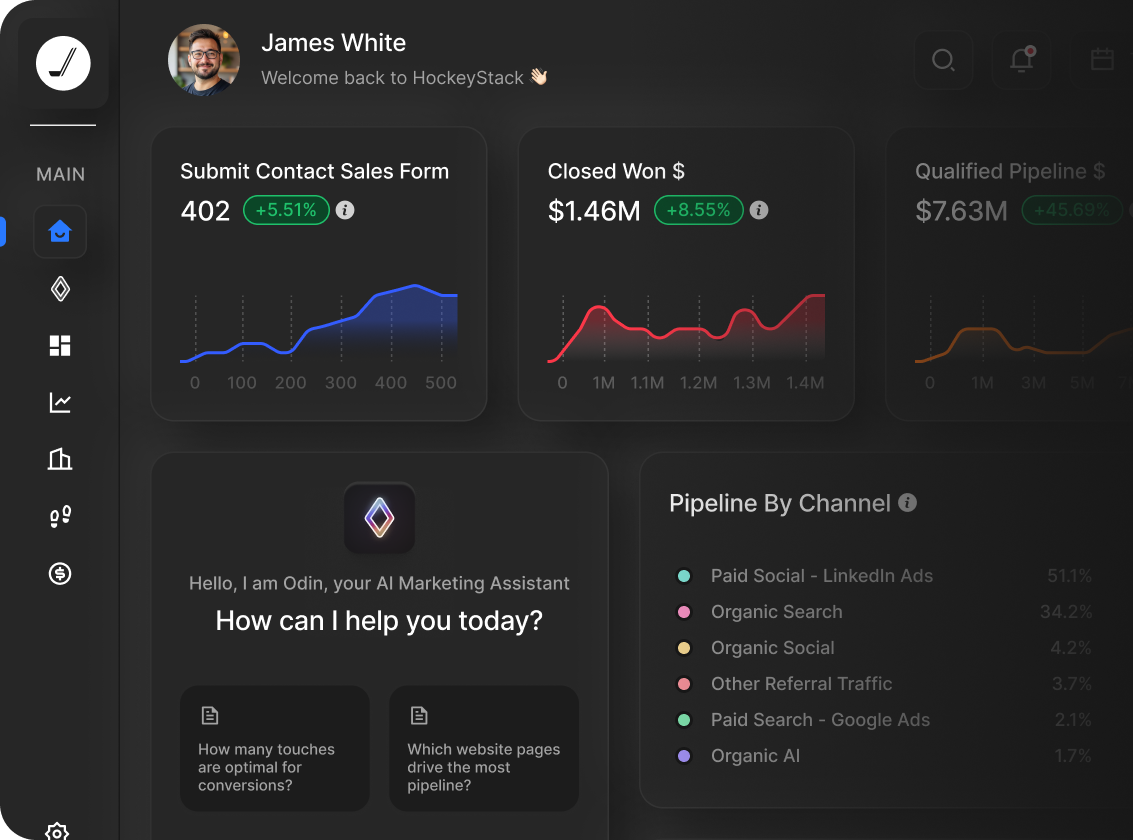
If you're a B2B GTM leader who can't get a straight answer about what drives revenue, can't align your teams, and can't trust your data, you probably don't need an alternative.
While point solutions close individual gaps, HockeyStack connects your entire GTM operation under one roof.
Most GTM stacks look like a Frankenstein setup. You buy one for attribution, another for intent data, a third for sales intelligence, and maybe a fourth to tie them together. Each one does its job, but they don't communicate, and you end up spending hours reconciling data.
HockeyStack handles this through three layers that stack on each other:
- Atlas brings all your GTM signals together: Marketing campaigns, sales activities, website behavior, and product usage all flow into one intelligence layer. You see complete buyer journeys instead of trying to piece together fragments from multiple tools.
- Odin analyzes and surfaces what matters: It outlines which accounts show buying intent, pinpoints where your pipeline stalls, and connects campaigns to revenue (not just MQLs). You get intelligence, not more charts to interpret.
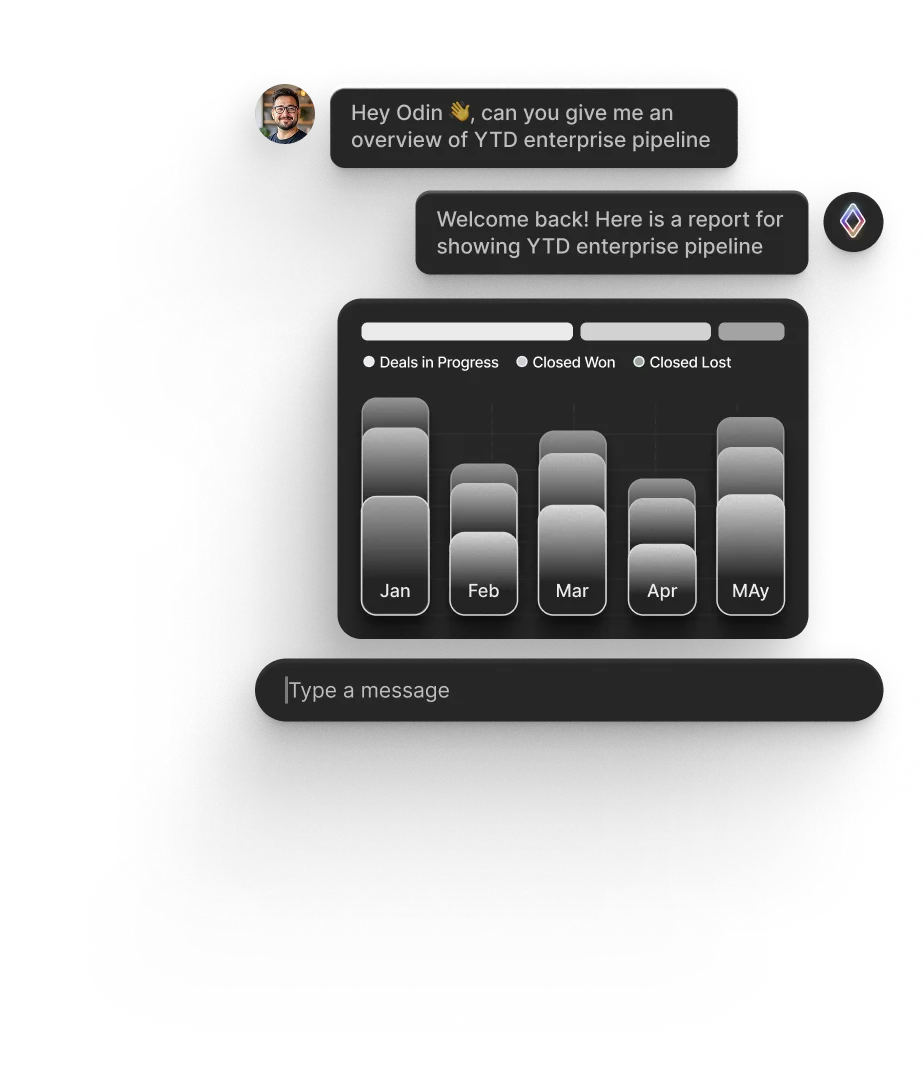
- Nova executes on those insights: It writes personalized outreach, prioritizes accounts for your reps, and routes leads to the right people. The AI handles the heavy lifting so your team can focus on closing.
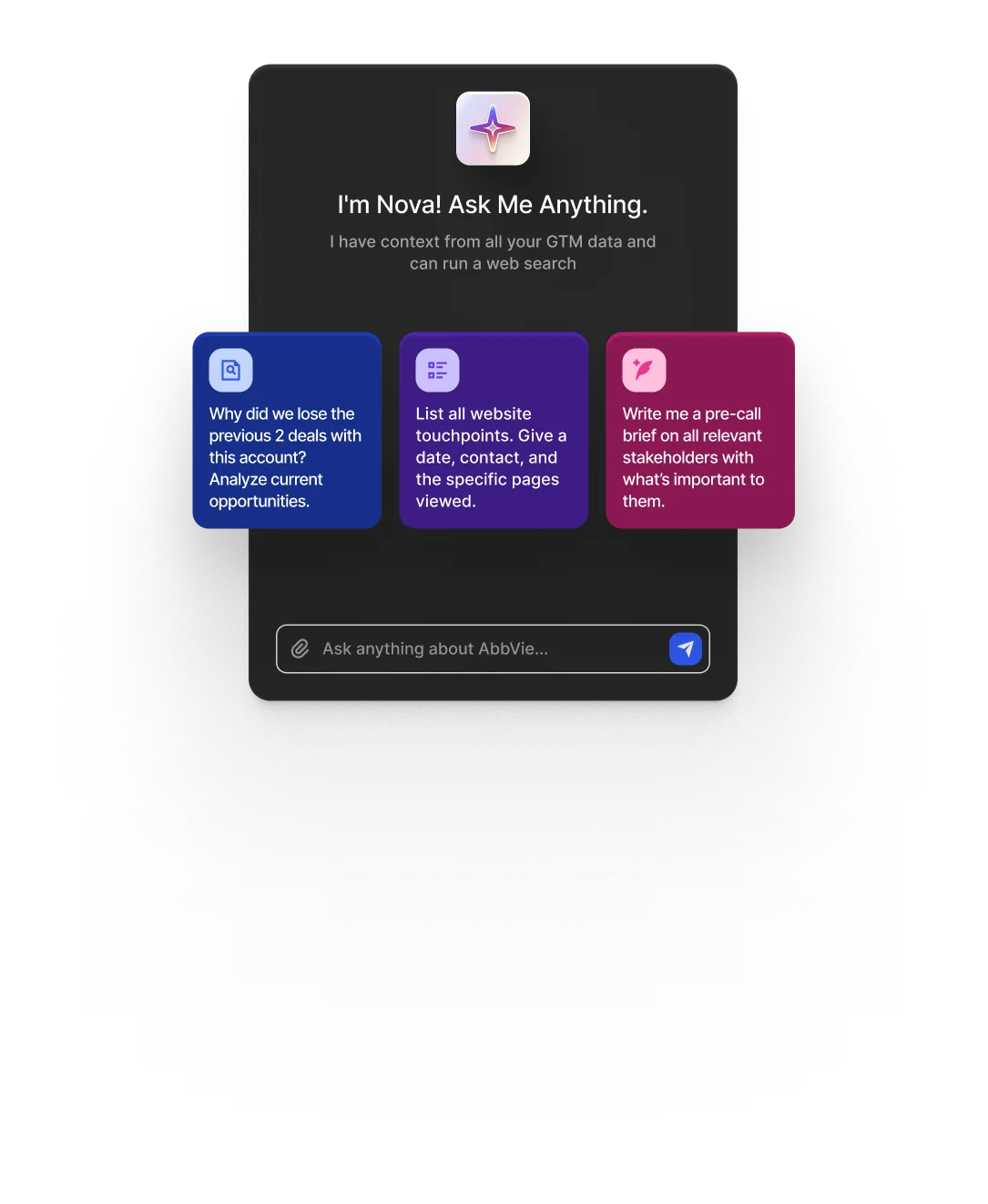
- Workflows automate the coordination: When an account hits a threshold score, HockeyStack triggers a sequence in Outreach, creates a task in Salesforce, and notifies your AE in Slack. One signal creates coordinated action across your entire stack.
This is the difference between buying more tools and building a revenue engine. Point solutions fill your dashboards, while HockeyStack builds the operating system your GTM motion runs on.
n8n faced a different but related challenge. With 1,000+ inbound leads weekly and a lean team, their reps spent 30 minutes before each call manually piecing together prospect intel from Salesforce, recordings, and website data.
HockeyStack's Account Intelligence consolidated everything into automated meeting briefs and built a lead scoring model that doubled conversion rates on high-intent leads.
“The HockeyStack team focuses on our problems and the challenges we’re trying to solve, versus pushing a solution onto us.” — Anne-Charlotte Chauvet, Head of Revenue Operations @ n8n
If your current setup works and your team doesn't mind jumping between platforms to piece together actionable insights, the alternatives above might fit.
But if you need a system that unifies attribution, intelligence, and execution without technical gymnastics, HockeyStack delivers that straight out of the gate.
Test the platform with our interactive demo and find out why leading B2B teams run their GTM motion on HockeyStack.
FAQs
How is HockeyStack's data unification different from just using a CDP + BI tool?
When you use a CDP with a BI tool, you need to build your own GTM data models and analysis from scratch. This usually takes months and major technical resources.
HockeyStack ships with that intelligence layer already built. Other than that, HockeyStack includes Workflows that take actions based on what the data tells you. A CDP and BI tool just shows you charts.
Are HockeyStack's AI agents (Odin & Nova) really different from the AI features in other tools?
Most AI features in marketing tools operate in isolation. An AI email writer can't see your attribution data, and an AI analyst can't execute sales workflows.
Odin and Nova operate on your complete GTM dataset. Odin outlines patterns across marketing and sales, while Nova translates those patterns into execution guidance for reps.
Both connect directly to Workflows that execute actions across your stack. They're part of one system, not separate features bolted onto different tools.
How quickly can I expect to see ROI with HockeyStack compared to just adding a point solution?
Point solutions deliver narrow wins. You save time on one task, but your GTM engine still runs the same way.
On the other hand, HockeyStack creates immediate value by unifying your data in hours. You stop manually building reports and spot wasted budgets right away.
The ROI grows from there. Odin spots patterns you couldn't see before, workflows automate what used to need five manual steps, and your pipeline starts moving faster without hiring anyone new.
Is HockeyStack meant to replace my CRM or Marketing Automation Platform?
Not at all. HockeyStack plugs into your existing CRM and marketing automation setup. You keep Salesforce for pipeline management, HubSpot for campaign execution, or whatever tools you use now.
HockeyStack functions as the orchestration layer on top. It pulls data from your systems, identifies what matters, and sends actions back into those same tools through workflows. Your team keeps their familiar interfaces.
Ultimate Guide To B2B SaaS Data Analytics
Discover the essential B2B SaaS analytics tools and metrics you need to track, along with how to leverage data-driven insights to optimize your strategies.

More Blog Posts
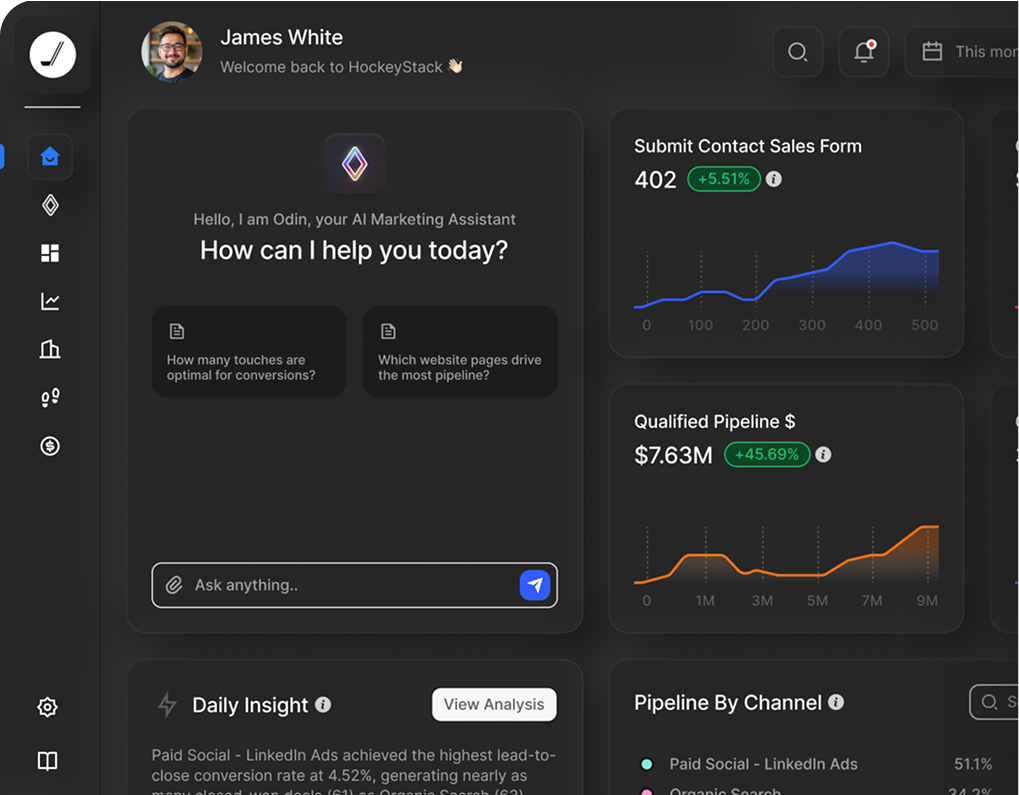
Ready to see HockeyStack in action?
HockeyStack turns all of your online and offline GTM data into visual buyer journeys and dashboards, AI-powered recommendations, and the industry’s best-performing account and lead scoring.
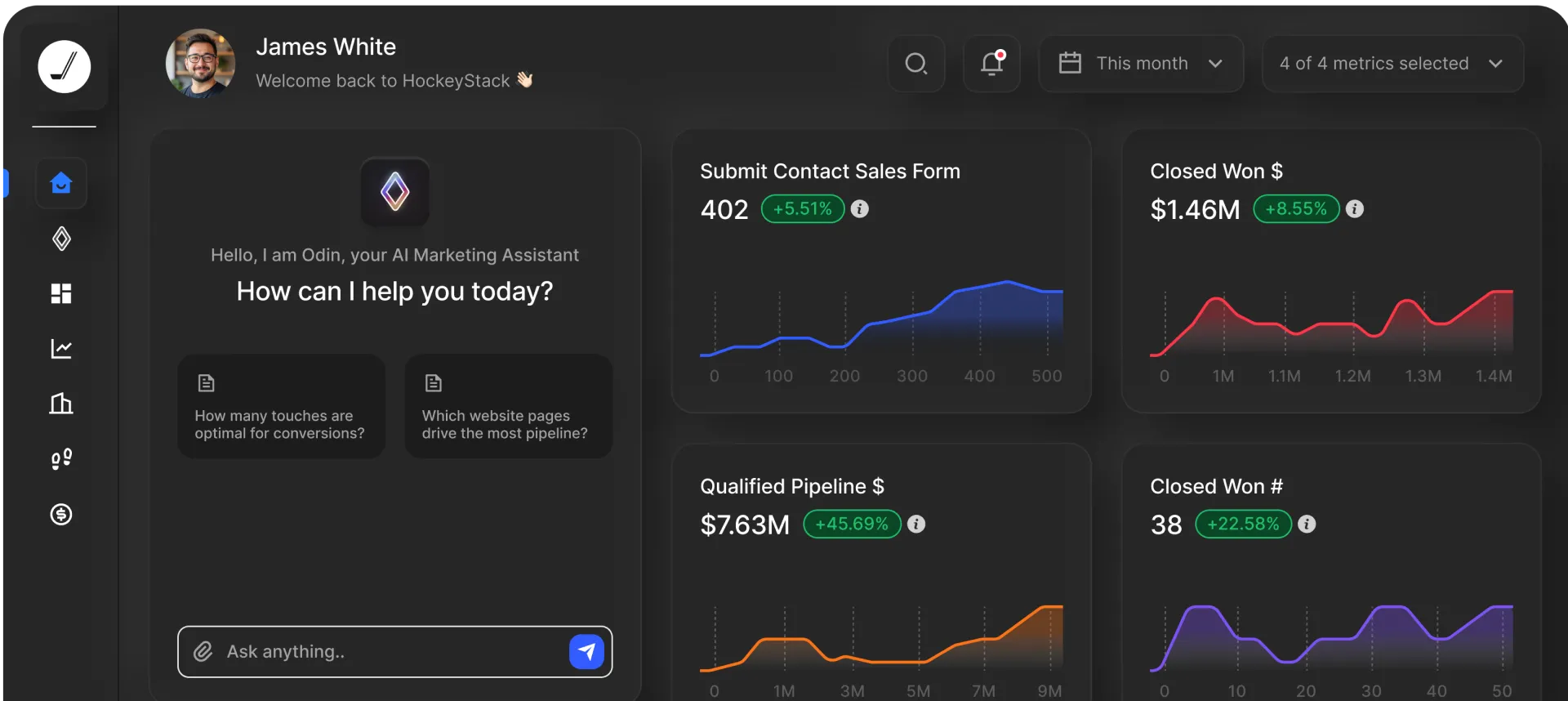
Ready to See HockeyStack in Action?
HockeyStack turns all of your online and offline GTM data into visual buyer journeys and dashboards, AI-powered recommendations, and the industry’s best-performing account and lead scoring.




